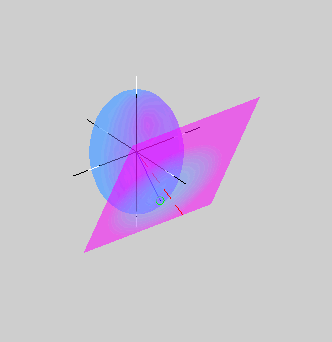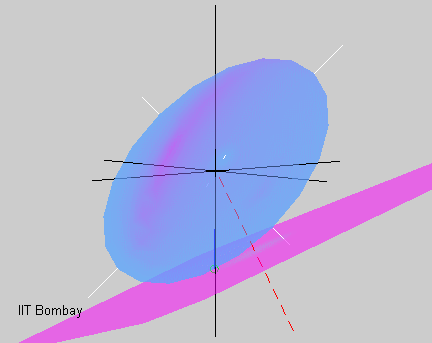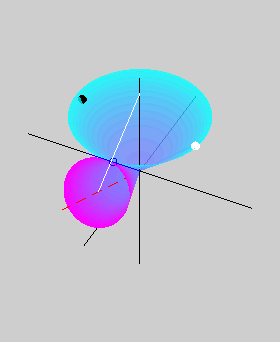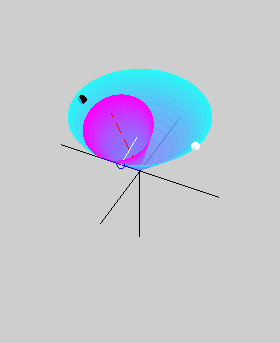Rotational Motion of an Axisymmetric
Torque-Free Rigid Body
The animations on this page depict the rotational
motion of an axisymmetric body that rotates freely in the absence of
any external torques. A body is said to be axisymmetric if any two of its
three principal moments of inertia are equal. The axis corresponding to
the third moment of inertia is called the axis of symmetry. Note that
such a body may not appear axisymmetric to look at. In other words, the
mass distribution may not be rotationally symmetric about the so called
axis of symmetry. For instance, a homogeneous right prism with a square
cross section will qualify as an axisymmetric body even though it does
not possess rotational symmetry. The kinetic energy ellipsoid of an
axisymmetric body is axisymmetric in the ordinary sense, that is, it is
a surface of revolution and has rotational symmetry about the axis of
symmetry.
An axisymmetric body having the axis of symmetry as
its minor principal axis is called prolate.
A tall and thin cylinder is an example of a prolate body. The kinetic
energy of a prolate axisymmetric body is symmetric about its 
longest geometric axis. The animation on the right shows the kinetic
energy ellipsoid of a prolate axisymmetric body rolling without
slipping on the invariant plane as the body rotates. A comparison with
similar simulations of a rotating asymmetric
body shows that the rotational motion of an axisymmetric body is
smoother and more regular. This is because, in the axisymmetric case,
the kinetic energy ellipsoid has circular cross sections.
The green circle shows the tip of the angular
velocity vector. As the body rotates, an inertial observer sees the
angular
velocity vector tracing out the herpolhode
shown in yellow. However, an observer rotating with the body
sees
the same angular velocity vector tracing out the polhode shown in red. The pink
curve shows the path traced out by a point on the minor principal axis
of
inertia.
Unlike in the asymmetric case, all three curves are circles, and the
minor principal axis, which is the symmetry axis for a prolate body,
exhibits only precession without any nutation.
An axisymmetric body is called oblate if its axis of symmetry is
its major principal axis of inertia. A short, fat circular cylinder is
an example of an oblate axisymmetric body. The kinetic energy ellipsoid
of an oblate body is symmetric
 about its shortest geometrical axis. The simulation on
the left shows the kinetic energy ellipsoid of an oblate axisymmetric
body rolling without slipping on the invariant plane as the body
rotates. As in the prolate case, the herpolhode (in yellow) and the
polhode (in red) are circular.
about its shortest geometrical axis. The simulation on
the left shows the kinetic energy ellipsoid of an oblate axisymmetric
body rolling without slipping on the invariant plane as the body
rotates. As in the prolate case, the herpolhode (in yellow) and the
polhode (in red) are circular.
Both the animations above show that the angular
velocity vector (the blue segment) of an axisymmetric body traces out a
cone in the body frame. This cone, called the body cone, intersects the
kinetic energy elliposid in the polhode and has the symmetry axis as
its axis. The angular velocity vector also traces out a cone as seen by
an inertial observer. The axis of this space cone is along the angular
momentum vector (dashed red line), and its intersection with the
invariant plane is the herpolhode. While the space cone remains
stationary with respect to an inertial observer, the body cone moves
such that the line of contact between the two cones is along the
angular velocity vector. Since material points in the body that lie
along the angular velocity vector are instantaneously stationary with
respect to the inertial frame, it follows that the body cone rolls
without slipping on the space cone as the axisymmetric body rotates.
This motion of the body cone thus provides an alternative geometric
description of the rotational motion in the special case of an
axisymmetric body.
The two animations below show the body cone
(in cyan) rolling on the space cone (in magenta) without slipping. The
animation on the left is for a prolate body, while that on the right is
for an oblate body. The red dashed line shows the angular momentum
vector, which is also the axis of the space cone. The axis of the body
cone, which is also the axis of symmetry, is shown in white. The pink
curve is the path of a point on the axis of symmetry. The small blue
circle shows the tip of the angular velocity vector lying along the
line of contact of the two cones. The tip of the angular velocity
vector traces out the green herpolhode on the space cone as well as the
red polhode on the body cone. The blue circle also lies along the white
line joining the angular momentum vector and the axis of symmetry, thus
showing that the angular momentum vector, the angular velocity vector,
and the axis of symmetry all lie in the same plane (could you observe
this in the two animations above?). However, while the angular velocity
vector lies between the other two in the prolate case, it is the
angular momentum vector that lies in between in the oblate case.
Consequently, the space cone lies outside the body cone in the prolate
case, but inside it in the oblate case. This difference gives rise to prograde and retrograde precession in the
prolate and oblate cases, respectively. The black and white circles on
the body cone are meant to help visualize the rotational motion of the
body cone better.


The animations appearing on this page were created
with the help of Debashish Bagg.

 about its shortest geometrical axis. The simulation on
the left shows the kinetic energy ellipsoid of an oblate axisymmetric
body rolling without slipping on the invariant plane as the body
rotates. As in the prolate case, the herpolhode (in yellow) and the
polhode (in red) are circular.
about its shortest geometrical axis. The simulation on
the left shows the kinetic energy ellipsoid of an oblate axisymmetric
body rolling without slipping on the invariant plane as the body
rotates. As in the prolate case, the herpolhode (in yellow) and the
polhode (in red) are circular. 

